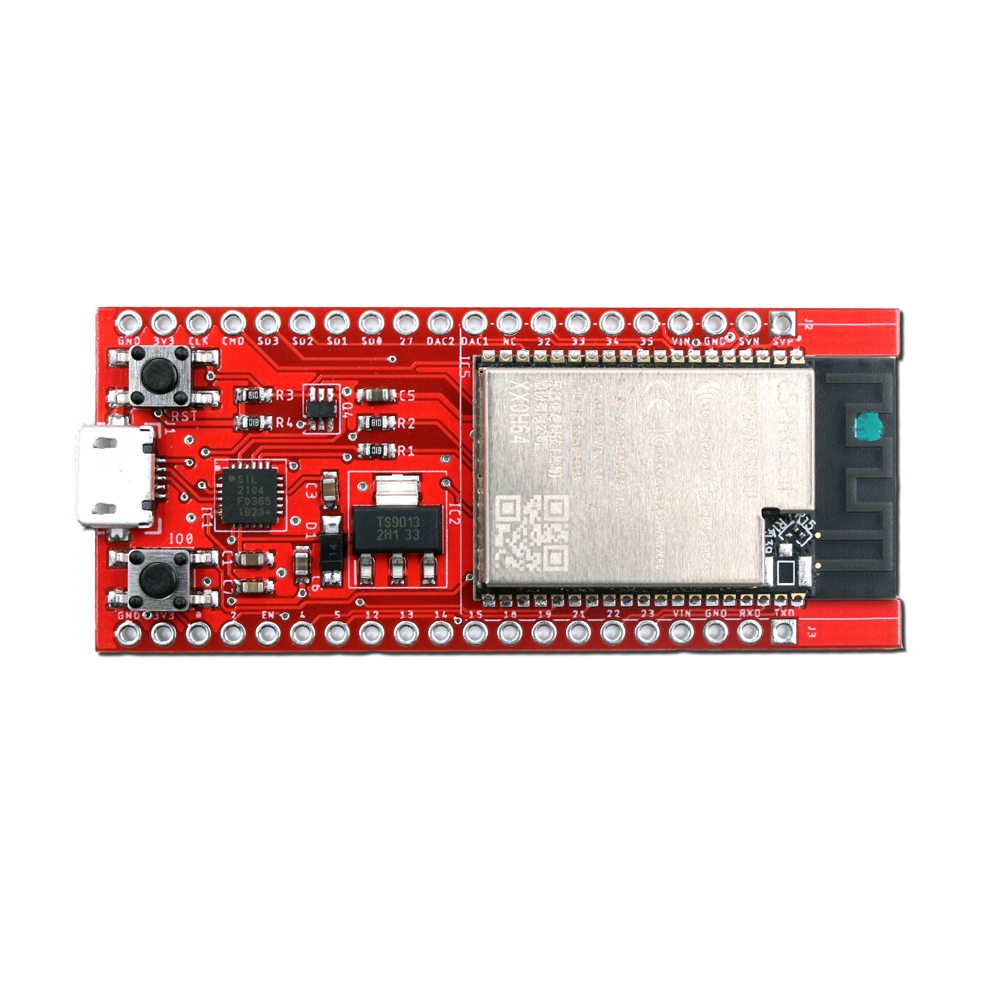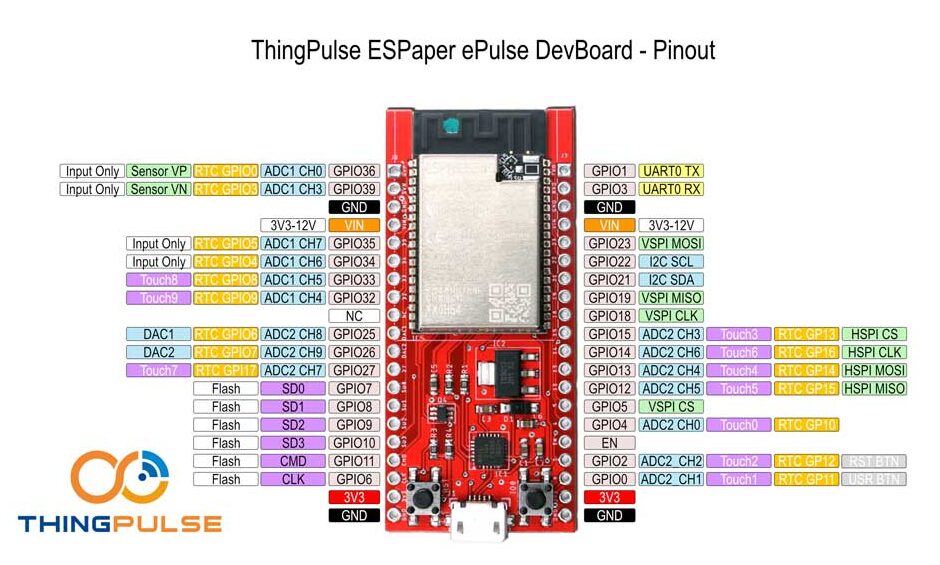Description
Low Power ESP32 development board. The ePulse from ThingPulse is the perfect companion for your battery-powered projects.
Technical Specifications
| Microcontroller | ESP32-D0WD |
|---|---|
| ESP32 Module | ESP32-WROVER-B |
| Input Voltage (VIN pin) | 3V3 – 12V |
| Power Consumption Deep Sleep | <25uA (at 3.3V), < 35uA (at 12V) |
| GPIO Pins | 30 |
| Flash | 8M bytes |
| PSRAM | 8MB (currently only 4MB addressable) |
| UART | CP2104 |
| LDO | TS9013SCW |
| Board Dimensions | 52.1 x 86.8mm |
Optimized for Low Power Consumption
ePulse, the low power ESP32 development board, is optimized for applications where a low sleep current and a wide range of input voltage are required. The VIN pin accepts voltages between 3V3 and 12V. When the ePulse board is in deep sleep it only consumes between 25uA (at 3V3) and 35uA (at 12V). Most ESP32 and ESP8266 board consume around 100 – 130uA.
This low sleep consumption is perfect for applications where the device sleeps most of the time and only wakes up from time to time to complete a task. For instance, a WiFi remote control for home automation can sleep until the user presses one of the buttons. The device wakes up, connects to WiFi, sends the command over MQTT and goes back to sleep until the next time a button is pressed.
We also made sure that the integrated serial-2-usb chip is only consuming power when the device is powered through the USB port. Please note that to reduce standby power consumption this module comes without any status LEDs.
Ideal Form Factor for Prototyping
The size of the ePulse dev board is perfect to fit into a breadboard and leave one row of pins free for prototyping your circuit. We also took care that the dev board’s PCB doesn’t block the antenna of the ESP32 module. This leads to better signal strength for transmission and reception.

Easy Programming
The onboard UART CP2014 by Silicon Labs lets you easily program the ESP32 from your Windows, Mac or Linux computer. In our tests, we could use the highest transmission rates of 921600 bauds to re-program the chip within seconds. Regular ESP32 upload programs can automatically set the module into flashing mode.
Powerful ESP32 Module
This board takes advantage of the ESP32-WROVER-B module which breaks out many of the ESP32’s pins. It also comes with 8MB PSRAM which enables you to implement memory-hungry applications like embedded machine learning or using a graphics driver with a frame buffer. Please note that current software stacks might limit the PSRAM usage to 4MB. The WROVER-B module has passed several certification programs like FCC and CE.
The ePulse development board gives you access to no less than 30 GPIO pins.
From Makers For Makers
This module has been designed with the needs of makers in mind. We love to build a prototype first on a breadboard before creating a PCB for it. And we love to share our creations with the community. Fritzing is a beautiful app to document breadboard circuits and we want to support you in doing so. That’s why we created a Fritzing part file for the ePulse module. You can download it from this github repository.






David Bird aka G6EJD (verified owner) –
Excellent board arrived as scheduled. Has a quality control sticker indicating that some pre-delivery inspections took place, always a good thing. Deep sleep current was measured as 25uA which is class leading, overall it’s a very good development board. Could be augmented with a battery /Vin pin monitor and a battery charger but otherwise an excellent board and perfect for low power solutions.
Mike Field (verified owner) –
Boards arrived yesterday. Tested with a simple project. 27.4 mA with CPU running (WiFi off), 23.50 nA in deep sleep, just as advertised.
Seems perfect for a battery powered sensor project that needs the occasional bit of WiFi.
Josef Zvolanek (verified owner) –
Beautiful development board, with consumption with the official example ESP32 28.4uA It could be extended by a battery connector and battery voltage measurement!
JoL1hAHN –
Low power consumption, truly breadboard-friendly design, good routing of the internal GPIOs to the breakout pins, unobstructed RF antenna, and it properly switches to program mode without holding down the BOOT button. It’s really hard to find all those characteristics in just one ESP32 development board, I think it’s probably the best one around right now and it comes at a very fair price so I can’t really demand more.
James T Cullins –
The rating is for the webpage as I have not ordered one yet.
Christophe –
Looks nice.
Can I feed it with 3 AA batteries NiMH (1.2V , 2500 mAH, Maximum Discharge Current 1.0 CmA) ? Can it support Wifi under these conditions ?
Marcel Stör –
The VIN pin accepts voltages between 3V3 and 12V. Hence, powering it from 3 AA batteries should be fine.
Claus Kühnel (verified owner) –
Excellent low-power IoT board. I used it in several projects already:
– https://ckarduino.wordpress.com/2020/04/29/epulse-esp32-das-warten-hat-sich-gelohnt/
– https://ckarduino.wordpress.com/batteriebetriebene-iot-knoten/
– https://ckarduino.wordpress.com/2022/08/13/solar-power-system-fur-iot-knoten/
Marcel Stör –
Thank you Claus, we’re glad the ePulse fulfills your expectations.
Jean F Delpech –
Excellent board, lasts several months in low power mode on 4 AA batteries while sending a sizeable MQTT packet by WiFi every 20 minutes.
Could you notify me when it will be in stock again? I need 5 of them
Thanks
Marcel Stör –
Thank you Jean, we’re happy you like it 🙂 I invite you to follow us on Twitter and/or subscribe to our newsletter to be among the first to learn about ThingPulse news.
Marcel Stör –
Jean, not sure if you saw this but we’re still taking preorders for the new ePulse Feather: https://thingpulse.com/product/epulse-feather-low-power-esp32-development-board/